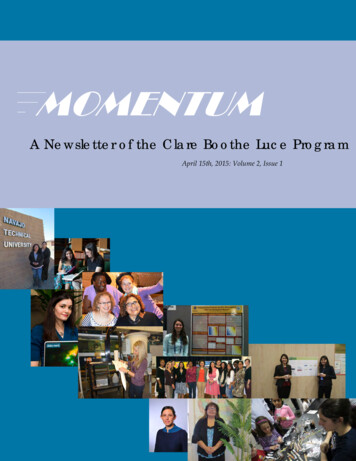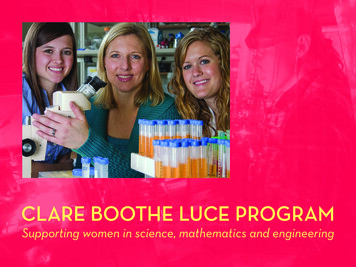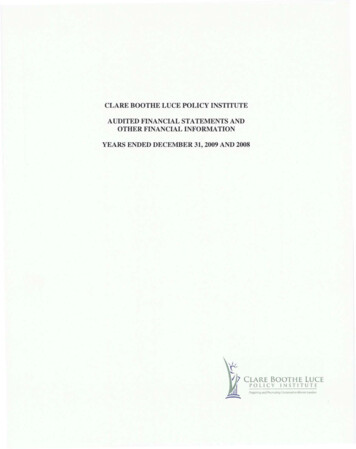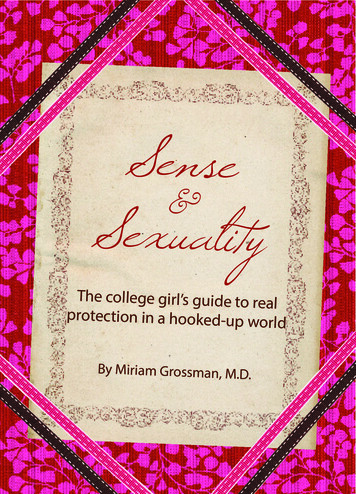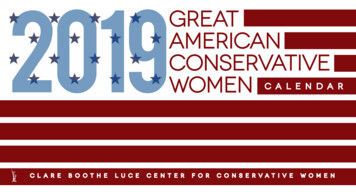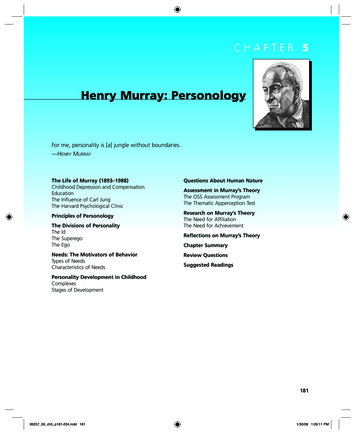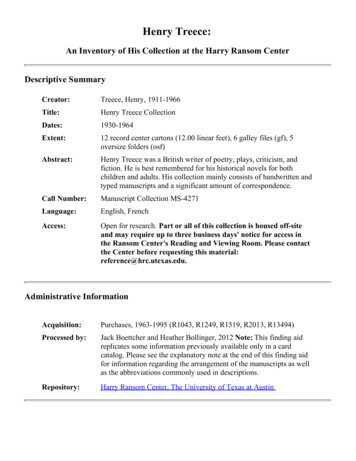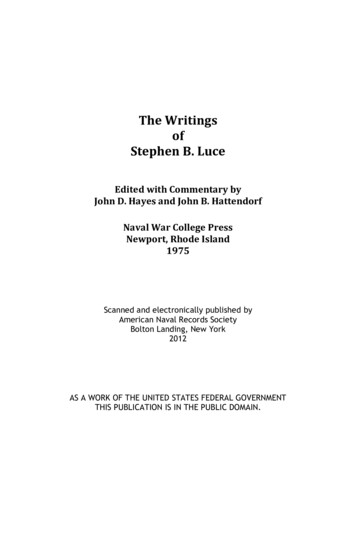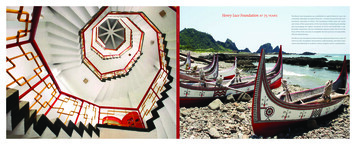
Transcription
HENRY LUCE FOU NDATION AT 75 YE AR SHenry Luce Foundation at 75 yearsThe Henry Luce Foundation was established in 1936 by Henry R. Luce, theco-founder and editor-in-chief of Time Inc., to honor his parents who weremissionary educators in China. The Foundation builds upon the visionand values of four generations of the Luce family: broadening knowledgeand encouraging the highest standards of service and leadership. A notfor-profit corporation, the Luce Foundation operates under the laws of theState of New York and aims to exemplify the best practices of responsible,effective philanthropy.The Henry Luce Foundation seeks to bring important ideas to the center ofAmerican life, strengthen international understanding, and foster innovation and leadership in academic, policy, religious and art communities.0124.JACKET.indd 12/14/12 1:55 PM
0124.COV EMBOSS.indd 12/13/12 2:35 PM
Henry Luce Foundation at 75 years0124.P.indd 12/8/12 4:02 PM
Produced in celebration of the 75th anniversary ofthe Henry Luce Foundation, winter 2011–2012 2012 Henry Luce FoundationWritten by Theodora Lurie and Michael GilliganPublication team chaired by Toby Alice Volkmanand assisted by Amy BonnaffonsEditorial management by Theodora LurieImage research by Helen RubinsteinDesign & production supervision by Julie FryPrinted by Meridian PrintingHenry Luce Foundation51 Madison Avenue, 30th FloorNew York, New York 10010www.hluce.orgcover: Aboriginal boats, Orchid Islandback cover: Pagoda staircase, Taroko Gorge, Taiwanphotos by david shirk0124.P.indd 22/8/12 4:02 PM
From the Board Chair4From the President5Interview withH. Christopher Luce7STAYING POWER11ADVANCING KNOWLEDGE21STRENGTHENING INTERNATIONAL UNDERSTANDING2833FOSTERING INNOVATION41BUILDING BRIDGES49PROMOTING LEADERSHIPLuce Scholars Program57Timeline62Board and Staff 640124.P.indd 32/8/12 4:02 PM
photo by charles gauthierFrom the Board Chairin 2008, the henry luce foundation made a grant to West Virginia University, in collaboration with the Jingdezhen Ceramics Institute — a uniquepartnership between an American university and what is considered China’s finest ceramics art and design school. As I reflect on that grant with itsalliance of purpose and practice, education and art, teacher and apprentice,and — most significantly — East and West, I am reminded of what my greatgrandfather Henry Winters Luce, and our Foundation “father,” Henry Robinson Luce, exhorted: May all human endeavors seek to create “under heaven,one family.” For me, such a grant represents a symbolic convergence ofpeople, place and mission.Henry Winters and Elizabeth Root Luce answered the missionary-educatorcall in 1897 by moving to China, which became their adopted home. In 1936their first child, “Harry,” as he was familiarly known, chose to honor theirlives of service by establishing the Henry Luce Foundation. He provided theoriginal intent and funding, but never served as a trustee. On the occasion ofits 75th anniversary, the Foundation honors his prescient call to engage witha world that today is much more interconnected.The Luce Foundation continues to fund initiatives that are rooted in ourmission and time-honored fields, and yet simultaneously encourage visionarythinking. Harry Luce was a man skeptical of utopian ruminations. Instead, heencouraged a culture of challenging discourse and provocative ideas.We welcome you to our celebration of what we feel is a history of innovative and imaginative grant making. May our work be worthy of ElisabethLuce Moore’s highest approbation, “Oh, Harry would love it!”margaret boles fitzgerald, chair40124.P.indd 42/8/12 4:02 PM
photo by ken levinsonFrom the Presidenton anniversaries, we bring out the family albums — telling stories andsquinting at old photos for early hints of what we would become. For thefoundation created by the publisher of Time and Life magazines, the retrospective glance is both rewarding and challenging. Henry R. Luce was certainly grounded in his own family’s history, but the focus of his work — andindeed of his intellectual excitement — was current affairs.Celebrating the Luce Foundation’s 75th anniversary, we seek a similarbalance in this publication. In the following pages, we examine how ourgrant making is faithful to Luce’s vision. We present examples of excitingprojects that today embody our mission. And we reach out toward the Foundation’s future.For the most part, our grants are organized according to programs andinitiatives — American Art, Asia, Higher Education, Luce Scholars, Public Policy, Religion and International Affairs, Theology, and Women in Science —which are described at our website. In this report, though, we look at thecommitments and strategies that link the programs. A catalyst for learningand leadership, the Luce Foundation brings important ideas to the center ofAmerican life and strengthens international understanding.Our 75th anniversary allows us, also, to say thanks: to the partnerswhose innovation we support; to the board and staff members who guide ourwork, year after year; to the team who have prepared this publication; and toHenry R. Luce for his generosity and vision. We look forward to adding pagesto our family album for years to come.michael gilligan, president50124.P.indd 52/8/12 4:02 PM
0124.P.indd 62/8/12 4:02 PM
Staying Powerfall 2011: The Willem de Kooning retrospective opens at New York’s Museumof Modern Art, to excellent reviews. Uptown, at The Metropolitan Museum ofArt, the updated Henry R. Luce Center for the Study of American Art is aboutto reopen. The Asian Art Museum in San Francisco presents Bali: Art, Ritual,Performance — the first large-scale exhibition in the United States of Balinesearts and culture. Remembering the Killing Fields, an exhibit that documentsthe stories of Khmer Rouge survivors, opens at Chicago’s Cambodian American Heritage Museum.In Cairo, a workshop convened by the University of California, Santa Barbara examines youth and religion in transitional Egypt. New York University’s Hemispheric Institute hosts policy roundtables in Mexico, Argentina andChile that analyze issues pertaining to church, state and society.Eight women scientists begin Clare Boothe Luce professorships in fieldsranging from aquatic ecology to electrical engineering. Dozens of undergraduate women receive scholarships for their studies in science, mathematics and engineering. The current Luce Scholars meet in Bangkok to report onthe first three months of their cultural immersion in Asian countries, just asthe city is inundated by record floods. One classmate, C. J. Stanfils, describeshis work in Laos with victims of unexploded ordnance, the legacy of U.S.Tiger’s Nest Monastery, Bhutanbombings that ceased in 1974, the same year the Luce Scholars Program forphoto by k atherine marshallyoung Americans began.In Pittsburgh, the most recent Henry Luce III Fellows in Theology present the results of their sabbatical research on such topics as the new demographic category of “spiritual but not religious,” and a comparative analysisof Hindu and Christian texts about longing for the divine.The American Art Renewal Fund makes its final grants, bringing to fiftyseven the number of museums around the country that received funds tohelp address the economic downturn’s effects on their operations. And thefirst grants from a new Luce initiative to advance Asian studies in liberal-arts70124.P.indd 72/8/12 4:02 PM
colleges through the lens of the environment allow schools to convene faculty teams to explore relevant projects.Yes, all in the last months of 2011 — and all with the Foundation’s support.In every season, with several hundred projects under way, we watch for signsof recent grants’ initial impact. But in our 75th anniversary year, our surveytakes a longer perspective and has greater resonance as we follow a threadfrom the founding intent, through some 6,700 grants, to our current work.With projects crossing many geographic and disciplinary boundaries,the “Luce link” may be difficult to discern at first. When and why do potential grantees turn to Luce? What distinguishes the Foundation today? Andwhat have we learned? We are unquestionably recognized for our long-termsupport of programs that echo the experiences and values of our founderHenry R. Luce and his family — Asia, theology, higher education, the arts.Luce described the Foundation as a tribute to his parents, missionary educators and cross-cultural pioneers. Like them, he embraced the future, recalling a note from his father: “We need the ardor of discovery, the forwardlook.” From his lead, we take a long view on impact, balancing steadfast commitment to core interests with openness to new ideas and opportunities.Because no minutes were kept, it is hard to say precisely what Henry R.Luce had in mind when he filed the papers of incorporation on ChristmasEve in 1936, nor what instructions he gave his wife, his sister and two colleagues from Time magazine two days later when they met to approve theFoundation’s first grant — 1,500 to Yenching University. But as we report onthe Henry Luce Foundation at 75 years, we hope that they would be as proudas we are of what the Foundation has built from their early vision.Trying to trace the trajectory from that modest beginning to the Foundation’s capacity and reputation today, we can look at quarter-century intervals, culling snapshots from earlier anniversaries so that we can describemore clearly the achievement the Luce Foundation celebrates at the 75th.The Foundation was still remarkably small in 1961, with a total of lessthan 1.7 million distributed in its first twenty-five years, and its work wasorganized informally. Only four of the 177 grants approved had been largerthan 75,000. Many were under 1,000. More than 80 percent of the grantswent to six organizations that had ties to the Luce family’s interests: theChina Institute, the United Board for Christian Higher Education in Asia,the National Council of Churches, Union Theological Seminary, the YMCAof Greater New York and the YWCA of the USA. There were no “grant-makingprograms,” as we would think of them today. More than 50 percent of theawards promoted understanding of Asia, primarily China; a little morethan 33 percent were for theological education and American religious life;and the remainder for a variety of civic organizations. With no other staff,luce foundation0124.P REVISED.indd 882/14/12 12:59 PM
a bookkeeper from the Time Inc. office supported the four board memberswho met once or twice a year to consider requests. Three of them — ElisabethLuce Moore, Charles Stillman and Roy Larsen — had attended the first boardmeeting. Henry Luce III joined the board in 1958, and the fourth originaldirector, Clare Boothe Luce, stepped down in 1960.Celebrating its 50th birthday at the Hotel Pierre in New York on a winter night in 1987, the Foundation announced six anniversary grants totaling 3.4 million — more than double the sum of all grants from our first quartercentury. The dramatic change in profile and scope had become possible withthe bequest of 68 million received after Henry R. Luce’s death in 1967. Theboard grew to nine and full-time professionals were hired. They maintainedthe original interests in Asia, theology, higher education and public policy,and shaped new initiatives: the Henry R. Luce interdisciplinary professorships (1968), the Luce Scholars Program (1974) and the first Luce Fund forAsian Studies (1975). When the corpus grew, then–executive director MarthaWallace wrote that it was time to consider a new area, and the Luce Fund forScholarship in American Art was announced in 1982, initially as a four-yearproject. By the 50th anniversary, the Foundation’s assets had grown to some 225 million, and our largest grant to date ( 2.5 million) had created the LuceCenter at The Metropolitan Museum of Art.Our growth over the most recent twenty-five years — in programs,resources, board and staff — is a more familiar story. The Foundation’s second large bequest followed Clare Boothe Luce’s death in 1987, and providedguidelines for a program to advance women’s careers in sciences, mathematics and engineering. While maintaining a responsive stance, the Foundationalso introduced multiyear initiatives, such as the Luce Fund for SoutheastAsian Studies, Theology and the Arts, Public Policy and the Environment,and most recently Religion and International Affairs. In the past decade wehave been able to make our largest grants, some reaching 10 million.With assets today of 750 million, the Foundation is among the nation’sone hundred largest — and recent approvals have moved total grants since1936 well past the 750 million mark. In the changing landscape of philanthropy, the Luce Foundation’s impact is directly related to its staying power,fostering the development of critical fields and the individuals who lead them.In the pages that follow, we present five themes that are woven throughthe fabric of our work. To illustrate these themes, we have chosen to profilesome of the creative accomplishments of institutions and individuals theFoundation has supported. At 75, the Luce Foundation plumbs the past forguidance, but celebrates the dynamism of the present and seeks to advance avision of excellence and innovation, responding to dramatic changes in theworld and in the institutions we seek to serve.90124.P.indd 9staying power2/8/12 4:02 PM
0124.P.indd 102/8/12 4:02 PM
Advancing Knowledgelike our peers, the Luce Foundation looks for niches and opportunitieswhere our financial resources and experience can genuinely add value.In challenging economic times, basic research is often threatened. Andthrough the recent downturn we have tracked the decline of funding forcore scholarship, particularly in the humanities and social sciences. As support from other sources has diminished, we have renewed our commitmentto a long-term priority: advancing knowledge. For us, this is both a practicaland necessary response to the times — and we trust that it is a sure link toHenry R. Luce, whose intellectual interests seemed boundless.Shortly after Henry R. Luce’s death in 1967, Time magazine colleagueHedley Donovan recalled his old boss: “Luce was indeed good at his job, hisself-assigned job of discovering everything he could about everything thatmattered, and sharing his discoveries with the widest possible audiences.”John K. Jessup, a Life magazine writer, described Luce’s “passionate need toknow, to inform, to educate, to improve the world.”Little wonder, then, that the directors of the Foundation wanted to usehis major bequest to pursue and share big ideas, as he had done, and in 1968launched the Henry R. Luce Professorship Program. They took as a modelLuce’s personal gift in 1955 to his alma mater, Yale University. Funding a facIslamic school near Yogyakarta, Indonesiaulty position at Yale Law School, he required that the professor also have aphoto by ted alcornregular assignment teaching history or political science to undergraduatesin Yale College.Over three decades, the Foundation supported seventy-two new facultyappointments at more than fifty private colleges and universities. With norestrictions on fields of study, the professorship program promoted excellence by reaching across the traditional academic disciplines. The focuswas on innovation, challenging schools to new practices of interdisciplinary teaching and learning, along with new levels of integration. Althoughwe have awarded no new professorships since 2002, we continue to trace the110124.P REVISED.indd 112/14/12 1:00 PM
impact of the positions still active at Bard College, the University of NotreDame and Princeton University (pg. 13).In 2005, the Foundation’s directors approved the Henry R. Luce Initiativeon Religion and International Affairs. Aimed at policymakers and the scholars who inform them, this initiative grapples with a shortfall in our nation’sforeign policy: the lack of attention to the world’s religions. What is distinctive is that the initiative includes all religious traditions — not just Islamand western Christianity — and that it takes up a spectrum of foreign-policychallenges: security and conflict resolution, of course, but also internationaldevelopment, human rights, gender issues and the environment.One of the first grants was to Columbia University’s School of International and Public Affairs (SIPA). With our support, Columbia createdthe Center for Democracy, Toleration, and Religion, where new courses andresearch initiatives explore such topics as human rights pragmatism, contested sacred spaces, and the intersection of religious law, secular reformand women’s rights (fig. 1).The University of California, Santa Barbara’s Orfalea Center is bringingscholars and practitioners together to create resources on the role of religionin global civil society, specifically geared to leadership training for international non-governmental humanitarian organizations. A new project atthe University of Notre Dame, Contending Modernities, springs from the recognition that secular and religious organizations cannot work independentlyto solve global problems of economic disparity, environmental degradation,mass violence and government corruption. Beginning with the two largestglobal religious communities, Catholics and Muslims, the project’s research1Ziba Mir-Hosseini, an Iranian Muslim feminist,engages in a lively debate at a workshop inAmman, Jordan. Who’s Afraid of Shari’a?, aproject that explores the relationship betweenwomen’s rights, activism and Islamic law,brought scholars and lawyers from ten countriesto Amman to discuss such questions as: DoesIslamic law pose a threat to women’s rightsand freedom? What can we learn from studyingthe effects of religious law on everyday livesof Muslim women in different places and times?The project is one of several research initiativesorganized by Columbia University’s Centerfor Democracy, Toleration, and Religion.photo by yahia shaheenluce foundation0124.P REVISED.indd 12122/14/12 1:00 PM
Emad Shahin, Henry R. Luce AssociateProfessor of Religion, Conflict and Peacebuildingat the University of Notre Dame, Indiana.courtesy universit y of notre dameCrossing Academic Boundaries“There is a very encouraging environment here for this kind of work.the henry r. luce professorship programin other cultures.”The students are curious to understand how people think and behaveAt Princeton University, Daniel Osherson holds a Luce Professorship in Information Technology, Consciousness and Culture. Acognitive scientist based in the Department of Psychology, OshersonWhen Emad Shahin, a political scientist and Middle East expert,works with colleagues from a range of other disciplines — linguistics,was appointed Henry R. Luce Associate Professor of Religion,philosophy, economics and computer science — to explore “what itConflict and Peacebuilding at the University of Notre Dame, hemeans to be human in the face of new technologies.” He has joinedembarked on two self-directed inquiries: as a specialist in Islamicwith professors from several of these fields to co-teach courses,law and politics now teaching at a Catholic university, Shahinand he created a monthly interdepartmental faculty seminar thatwanted to gain a deeper knowledge of Catholicism; as a memberdiscusses new research on such topics as human and artificialof the university’s Kroc Institute for International Peace Studies,reasoning, the neurological and evolutionary basis of cognition andhe sought to immerse himself in the literature on peace andthe role of language in thought.conflict resolution.In addition to distinguished academics, Luce Professors have“Notre Dame has some of the leading experts on these issues.also included public intellectuals from outside the academy. AtI wanted to build a bridge between the role Islamic values canBard College, a Luce Professorship in Human Rights and Journalismplay in promoting peace and the teachings of Catholicism and otherwas jointly held by two prominent investigative journalists — Markfaith traditions.”Danner and Ian Buruma. Through their books and their articles inShahin is one of several current Luce Professors in positionssuch publications as The New York Review of Books, they havemade possible by Foundation support to institutions that promoteilluminated complex political and cultural topics of internationalteaching and research across conventional academic boundaries.scope. Based in the Human Rights Program at Bard, both professorsSince 2009, Professor Shahin has taught courses at Notre Damedeveloped and taught courses that straddled history, politicalon such subjects as contemporary political Islam and globalization,science, literature, cinema and Asian studies. In 2008, Dannerdevelopment and democracy in the Middle East. He has alsoaccepted a chaired professorship at Bard, and Buruma has continuedexplored with his students and other colleagues Catholic andas sole Luce Professor at the college.Islamic perspectives on war and peace and the correlation betweenHis most popular courses cover a range of disciplines not typicallyCatholic social teachings and Islamic principles of social justice.combined in the classroom. For example, one course studied theFor a course on Islam and modernity, Shahin invited three otherrepresentation of great dictators in films, literature, journalism andfaculty members to provide a comparative examination of Catholictheater. “As a Luce Professor, I’ve had an enormous amount ofviews on the challenges of adjusting to a rapidly changing world.freedom to design courses that might not be easily categorized as“This great interdisciplinary mix has enriched my own knowledge,belonging in one specific department,” Buruma says. “You’ll findmy scholarship and my teaching,” he says. Students have also ben-human-rights majors in my classes, but also students from the musicefited from exposure to broader religious and cultural perspectives.conservatory, literature and psychology.” 130124.P REVISED.indd 132/14/12 1:00 PM
explores how the conflict between claims to exclusive truth and respect forreligious pluralism affects bioethical, gender and economic issues.Five years ago, few resources were available beyond Douglas M. Johnston’slandmark Religion: The Missing Dimension of Statecraft. Through the Initiativeon Religion and International Affairs, a shelf of new volumes has alreadyappeared, including Johnston’s two subsequent books on U.S. foreign policy;John Witte and M. Christian Green’s Religion and Human Rights: An Introduction; Rethinking Secularism, edited by Craig Calhoun, Mark Juergensmeyerand Jonathan VanAntwerpen; and Beyond Terror and Tolerance: Religious Leaders, Conflict and Peacebuilding, edited by Timothy Sisk. Blogs like the SocialScience Research Council’s The Immanent Frame have helped to expand theconversation beyond one-dimensional descriptions of religion or partisansound bites.Jacob Lawrence, The Migration Series, Panel no. 1:During World War I there was a great migrationnorth by southern African Americans, 1940–1941With the initiative’s focus on research, we hope to bring academic expertise to policy decisions, and to increase the public understanding of the influ-the phillips collection, washington, d.c. 2011the jacob and gwendolyn l awrence foundation,seat tle / artists rights societ y (ars), new yorkence of religion on global affairs. Across our programs, we have employedthis strategy — providing long-term support for scholars’ efforts, then helpingLouise Nevelson, installation view, The Sculptureof Louise Nevelson: Constructing a Legend, 2007them to influence the wider discourse through innovative dissemination.In the 1980s, the Foundation responded to another unmet need whenphoto by david heald;
Luce Moore, Charles Stillman and Roy Larsen — had attended the first board meeting. Henry Luce III joined the board in 1958, and the fourth original director, Clare Boothe Luce, stepped down in 1960. Celebrating its 50th birthday at the Hotel Pierre in New York on a win-ter night in 1987, the Foundation announced six anniversary grants totaling
